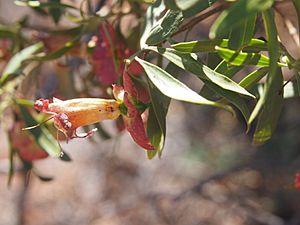Eremophila neglecta facts for kids
Quick facts for kids Eremophila neglecta |
|
|---|---|
 |
|
| Eremophila neglecta flower | |
| Scientific classification | |
| Genus: |
Eremophila (plant)
|
| Species: |
neglecta
|
| Synonyms | |
|
|
Eremophila neglecta is a beautiful flowering plant that belongs to the figwort family. It is found only in Australia, meaning it is endemic to that country. This plant is a shrub with many branches, and it has special lance-shaped leaves and bright orange-red flowers. You can find it growing in South Australia and the Northern Territory.
Contents
What Eremophila neglecta Looks Like
Eremophila neglecta is a shrub that can grow to be about 1 to 2.5 m (3 to 8 ft) tall. Its branches are often sticky and shiny because of a natural substance called resin. Many branches grow right from the ground. They feel rough because of the raised parts where old leaves used to be.
The leaves grow one after another along the branches. They are usually 20–40 mm (0.8–2 in) long and 3.2–6.8 mm (0.1–0.3 in) wide. They are shaped like a narrow spear and get thinner towards a short leaf stalk, which is about 2–4 mm (0.08–0.2 in) long. When the leaves are young, they are very hairy. But as they get older, they become smooth (which means glabrous), sticky, and shiny.
The Flowers of Eremophila neglecta
The flowers grow one by one where the leaves meet the stem. Each flower sits on a sticky, S-shaped stalk that is about 10–18 mm (0.4–0.7 in) long.
Each flower has 5 sepals, which are like small leaves that protect the bud. These sepals are egg-shaped and overlap each other. They are about 8–11 mm (0.3–0.4 in) long. The outside of the sepals is smooth, but their edges and inside are hairy. They can be orange, purplish-red, or yellow with a hint of pink.
The petals are about 20–25 mm (0.8–1 in) long and are joined at the bottom to form a tube. This petal tube is usually orange-red with red tips, and the inside is yellow with tiny orange spots. Sometimes, the whole petal tube can be pure yellow. Both the outside of the tube and the petal tips are covered with glandular hairs, which are hairs that produce sticky substances. The inside of the tube is full of long, soft hairs. There are 4 stamens (the parts that make pollen) that stick out beyond the end of the petal tube.
This plant mainly flowers from July to September. After flowering, it produces fruits that are woody and shaped like an oval or a cone with a wide base and a pointed end. They are about 6–8 mm (0.2–0.3 in) long.
How Eremophila neglecta Got Its Name
This plant was first officially described in 1914 by a person named John McConnell Black. He published his description in a science journal. The second part of its scientific name, neglecta, comes from a Latin word that means "disregarded" or "overlooked."
Where Eremophila neglecta Lives
Eremophila neglecta grows in the northern part of South Australia and the southern part of the Northern Territory. It likes to grow in stony clay soil on rocky hills and flat areas. You can usually find it in mulga woodlands, which are forests mainly made up of mulga trees.
Conservation Status
Good news! This plant is considered "of least concern" in the Northern Territory. This means it is not currently in danger of disappearing.
Uses of Eremophila neglecta
Traditional Uses
Aboriginal people used the leaves of Eremophila neglecta. They would make a special liquid from the leaves to help them feel good and stay healthy.
Growing Eremophila neglecta in Gardens
The bright red flowers of Eremophila neglecta are very pretty and attract birds that feed on nectar. It can be a bit tricky to grow new plants from cuttings (small pieces of the plant). Because of this, most garden plants are grafted. This means a piece of Eremophila neglecta is joined onto the rootstock (the root system) of another plant, often a Myoporum plant.
This plant can grow in many different types of soil. It grows best in full sun and can handle very dry conditions (it is very drought tolerant). It is usually only harmed by the coldest frosts.
Images for kids


